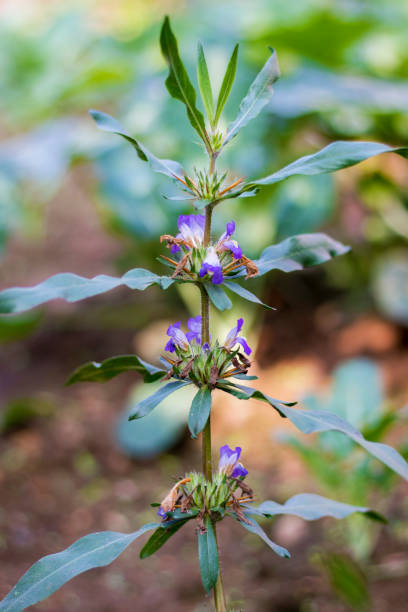

Hygrophila auriculata (Schumach.) Heine
|
It is commonly known as Talimakhana and belongs to the Acanthaceae family. Apigenin 7-O-glucuronide, Apigenin 7-O-glucoside, Luteolin, Ellagic acid, Gallic acid are some of the bioactives present in this plant. Leaves and aerial parts are cooked as vegetable. Methanolic extract of H. auriculata has anti cancer property. There was reduction in the levels of the antioxidant enzymes superoxide dismutase (SOD) and catalase (CAT) when tumor of mice were treated with methanolic extract. Mode of Consumption : Cooked |
| Plant Details | Agro-climatic Zone | Vernacular Names | Pictures |
| Scientific Name: Hygrophila auriculata (Schumach.) Heine Family: Acanthaceae Juss. Class: Magnoliopsida Order: Lamiales Genus: Hygrophila R.Br. Fruiting Season: June - September Parts: Leaves |
|
Bihar : Tal-Makhana Chhattisgarh : Tal-Makhana Delhi : Tal-Makhana Gujarat : Ekharo Haryana : Tal-Makhana Jharkhand : Tal-Makhana Kerala : Nirmuli Madhya Pradesh : Tal-Makhana Maharashtra : Talimakhana Rajasthan : Tal-Makhana Tamil Nadu : Golmidi Uttar Pradesh : Tal-Makhana Uttarakhand : Tal-Makhana West Bengal : Kullakhara |
 Plant |
| Compound/Extract | Activity | Mode of Action | Marker/References |
| Terpenoid fraction | Anti-inflammatory | Pre-treatment with Terpenoid fraction showed reduction in the expression of TNF-α, IL-1β, IL-6, superoxide dismutase (SOD), lipid peroxidation (LPO), and nitric oxide (NO) in the serum rats treated with LPS. | TNF-α, IL-1β, IL-6, SOD, LPO, and NO[1] |
| Methanolic extract | Anticancer | Treatment with methanolic extract in tumor-affected rats reduced the levels of the antioxidant enzymes superoxide dismutase (SOD) and catalase (CAT) while significantly increased the levels of thiobarbituric acid reactive substances (TBARS). | SOD and CAT[2] |
| Chloroform and alcoholic leaf extract | Anti-inflammatory, Antipyretic | Chloroform and alcoholic leaf extracts (400 mg/kg) reduce paw oedema in Carrageenan-induced rats. | [3] |
| Alkaloid fraction | Hepatoprotective | Treatment with total alkaloid fraction restored the increased levels of Aspartate amino transferase (ASAT), Alanine amino transferase (ALAT), Alkaline phosphatase (ALP), total Bilirubin, Lactate dehydogenase (LDH) and reduced levels of triglycerides (TGL), total proteins, and Albumin in CCl4 induced rat hepatocytes. | ASAT, ALAT, ALP, Bilirubin, LDH, and TGL[4] |
| Major Class | Metabolites (Content of bioactives: mg/100g Fresh Weight) |
| Effect | Observation | DOI |
| Disease | Formulation | Reference | Author | TKDL |
| Strength promoting, Aphrodisiac, Exhilaration | Mashpayawidichurnam | Bharata Bhaishajya Ratnakara - Vol. - IV | Compiled by Naginadasa Chaganalala Shah, Translated by Gopinath Gupta | Ayurveda |
| Bodily elemental tissue, Head, Ligament/s, Blood vessel, Disease with Vata predominance, Osteoarthiritis, Rheumatism, Kaphaja, Disease with Vata predominance, Immuno suppressive / Emaciating disease, Dyspepsia/Loss of appetite, Ankle/s, Knee/s, Thigh/s, Waist, Abdomen, Heart, Belly / Pelvic region, Axilla/e, Shoulder/s, Disease with Vata predominance, Jaw, Ear/s, Eyebrow/s, Forehead, Eye/s, Temple/s, Disease with Vata predominance, Urinary disorders / Polyuria, Dysuria, Colic, Tympanitis / Flatulence, Stone in Urinary Bladder / Urolithiasis / Urinary Calculus, Fat, Disease with Vata predominance, Torticollis, and Bodily elemental tissue, Pyrexia | Sathangadhritgaggulu | Bharata Bhaishajya Ratnakara - Vol.- V | Compiled by Naginadasa Chaganalala Shah, Translated by Gopinath Gupta | Ayurveda |
| Pyrexia, Cough / Bronchitis, Dyspnoea, Oedema / Inflammation, Curable disease of severe nature, Diseases of spleen, Urinary disorders / Polyuria, Dyspepsia/Loss of appetite, Colic, and Sprue / Malabsorption Syndrome | Sodhakalanlorassa | Bharata Bhaishajya Ratnakara - Vol.- V | Compiled by Naginadasa Chaganalala Shah, Translated by Gopinath Gupta | Ayurveda |
| Cough / Bronchitis, Leprosy, Colic, Disease, Gonorrhoea . | Abraha Parpam | Matchamuni perunool -800.CCRAS Publications. Chennai.(1985). | Matchamuni | Siddha |
| Cough / Bronchitis | Kizhi Muttai Thozh Parpam | Therayar Yamagam | Therayar | Siddha |
| Pyrexia | Kozhi Muttai Thozh Parpam | Therayar Yamagam | Therayar | Siddha |
| Ascites, Referred pain in the eye / Sphenoidal sinusitis, Anaemia / Hyperbilirubinaemia, Poisoning, Colic, Gastric ulcer/Acute gastritis, Dysuria, Vataja, Hernia, Dysentery/Gastroenterocolitis | Mandoora Centuram | Matchamuni perunool -800.CCRAS Publications. Chennai.(1985). | Matchamuni | Siddha |
| Colic, Pleurodynia and intercostal neuralgia, Pain, in Hand/s, Leg/s, Abscess, Scrofula / Cervical lymphadenitis, Leprosy and other dermatoses, Abscess, Leprosy and other dermatoses, Scabies, Itch, Alopecia, Urticaria/Allergic rashes, Cancer/ Carcinoma, Cancer/ Carcinoma, or Scrotum, Non-healing ulcer, Syphilis, Cervical erosion with ulcer, Ulcer / Wound, Gangrenous stomatitis/Cancrum oris, Diabetic furuncle, Perineal fistulas / Fistula-in-ano, Piles / Ano rectal mass / Haemorrhoids . | Rasaganthi Mezhugu | Pulippani vaithiyam - 500. | Pulippani | Siddha |
| Pyrexia, associated with Anasarca, Oedema / Inflammation | Sobha Sura Veeka Sura Kudineer | Therayar Kudineer. | Therayar | Siddha |
| Ascites, Anasarca, Jaundice, Anaemia / Hyperbilirubinaemia, Pain, in Extremities, Colic, Gonorrhoea, Dysuria, Sannipataja / Tridosaja, Ama, Hernia, Tuberculosis / Pthysis, Diarrhoea | Thiriloga Centuram | Matchamuni perunool -800.CCRAS Publications. Chennai.(1985). | Matchamuni | Siddha |
| Anasarca | Veekkathirku Kudineer | Therayar Kudineer | Therayar | Siddha |
| Information from Wealth of India | Reference |
|
CSIR(1948).The Wealth of India, Raw materials,Vol.-I ,P.133, New Delhi, India |
| 4.2, 4.2.1, 4.2.1.1, 4.2.1.3, 4.2.2.8, 4.2, 4.2.1, 4.2.1.1, 4.2.1.3, 4.2.2.8 |
| CSIR-North East Institute of Science and Technology, Jorhat-6, Assam, India
CSIR-Institute of Himalayan Bioresource Technology, Palampur-61,Himachal Pradesh, India |